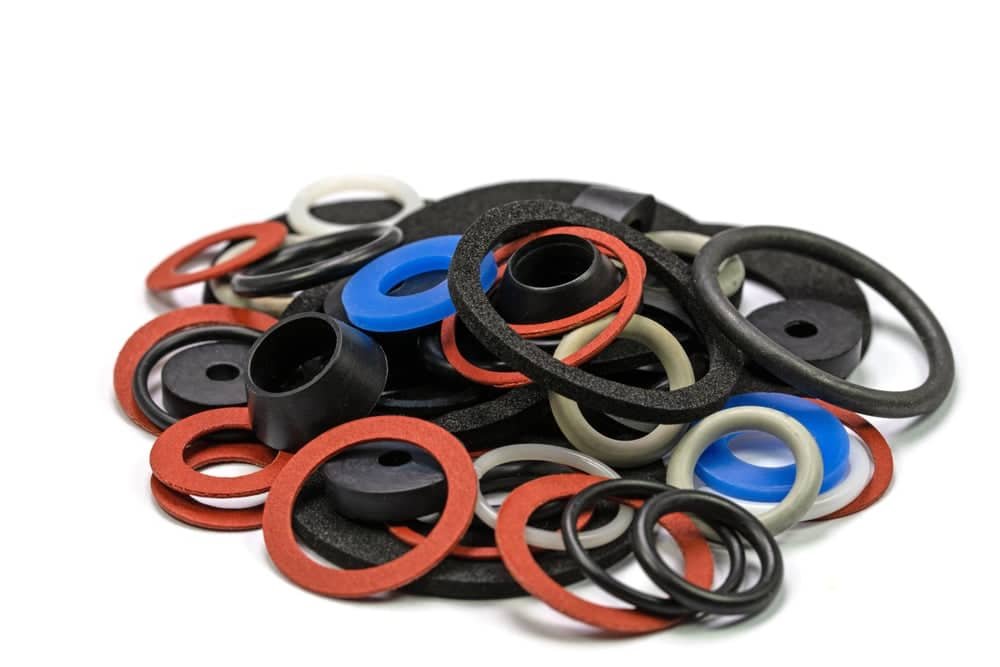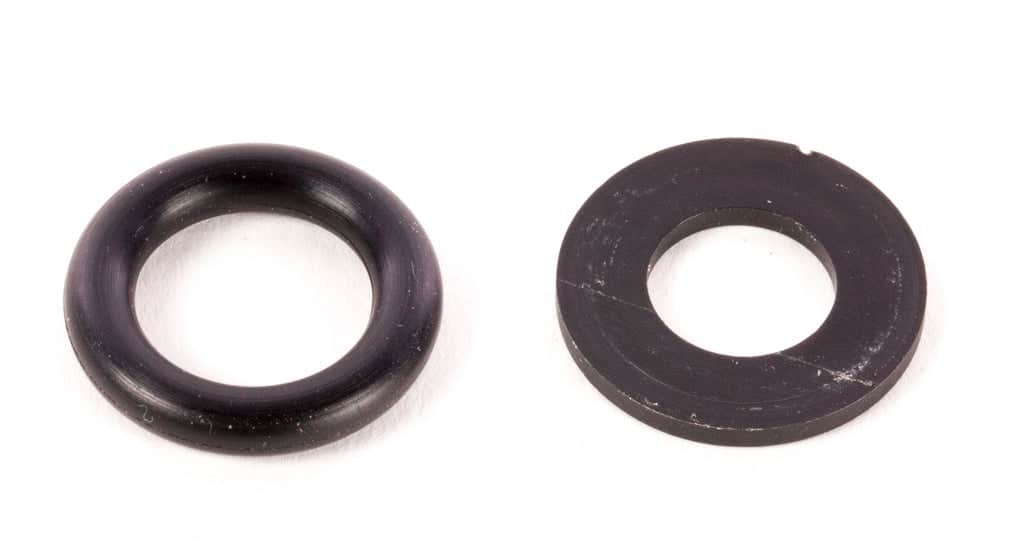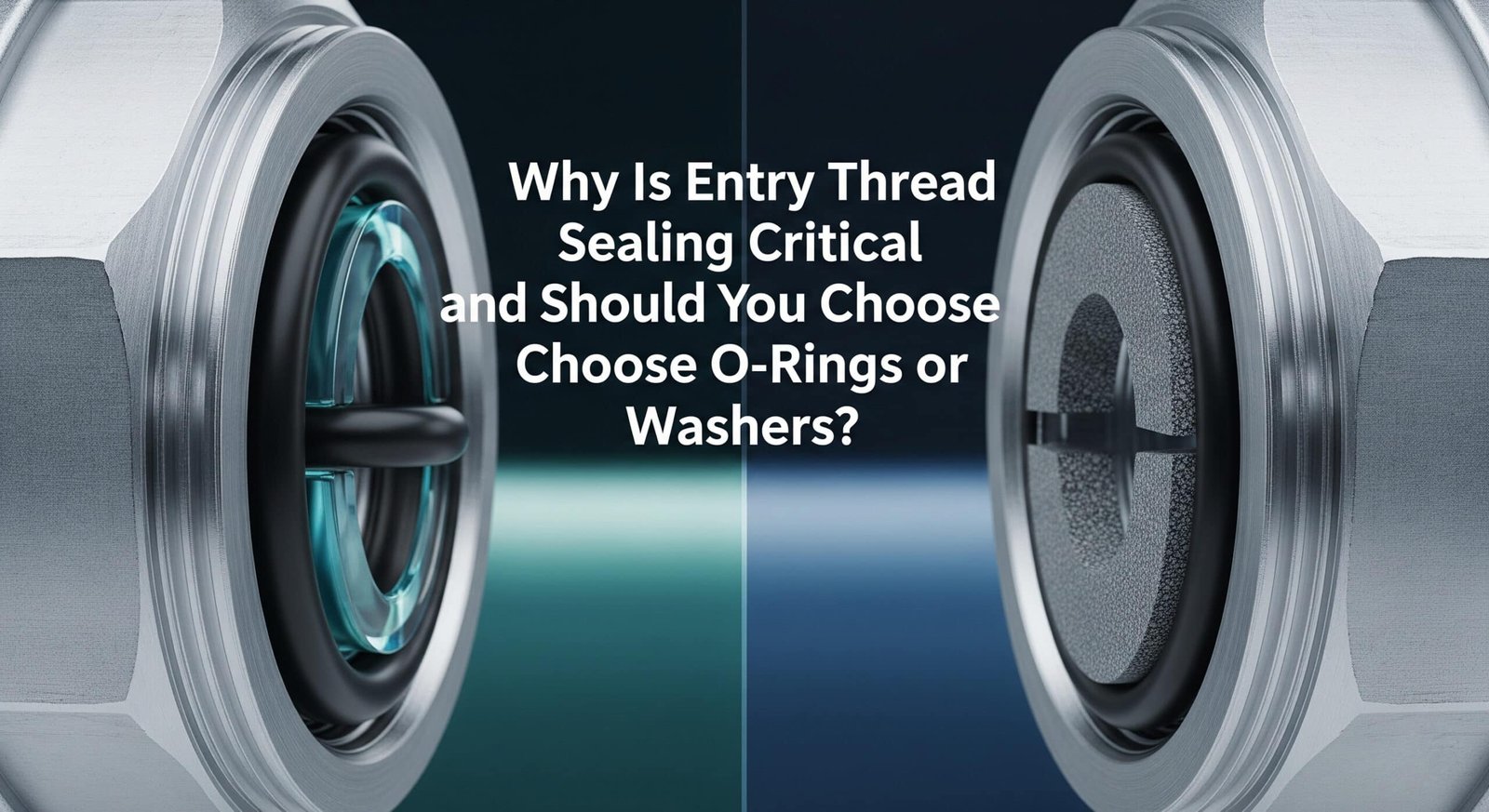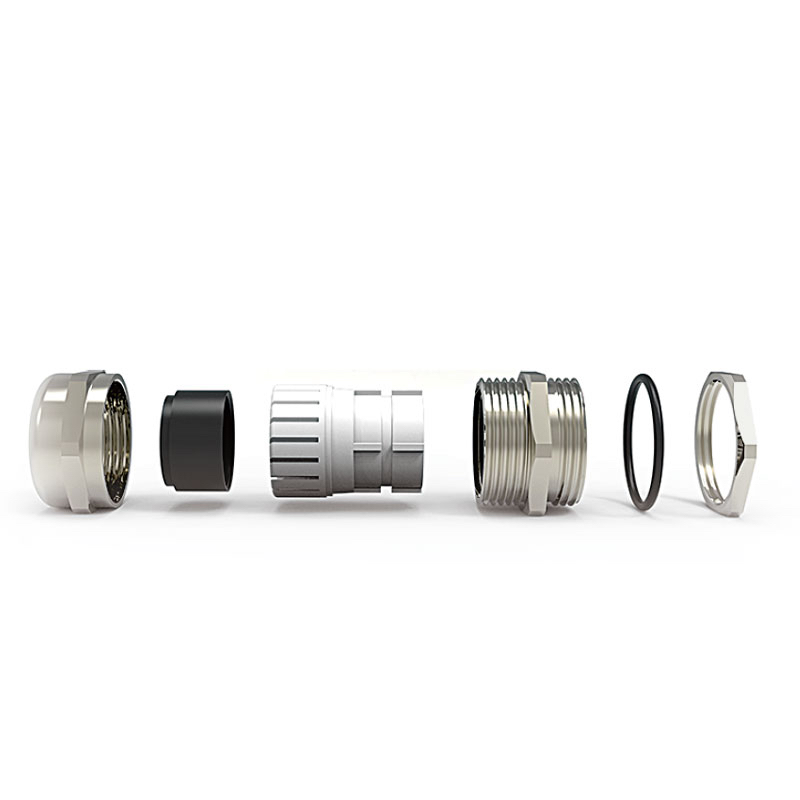
Entry thread sealing failures cause catastrophic equipment damage, electrical hazards, and costly downtime when moisture, dust, and contaminants penetrate cable gland connections, yet many installations use inadequate sealing methods that fail under pressure, temperature cycling, or vibration conditions. Traditional flat washers often compress unevenly, create leak paths, and lose sealing effectiveness over time, while improperly selected O-rings can extrude, crack, or degrade in harsh environments, leaving critical equipment vulnerable to environmental ingress.
Entry thread sealing is critical for maintaining IP-klassificering1 and preventing moisture ingress, with O-rings providing superior sealing performance through 360-degree contact and consistent compression, while washers offer simpler installation but limited sealing capability, making O-rings the preferred choice for demanding applications requiring reliable long-term protection. The choice between O-rings and washers depends on application requirements, environmental conditions, and performance expectations.
Having worked with facility managers across offshore platforms in the North Sea, chemical plants in Texas, and manufacturing facilities throughout Germany, I’ve seen firsthand how proper entry thread sealing can make the difference between reliable operation and costly failures. Let me share the critical knowledge for selecting the right sealing method for your cable gland applications.
Indholdsfortegnelse
- What Makes Entry Thread Sealing So Critical for Cable Glands?
- How Do O-Rings and Washers Compare for Thread Sealing?
- When Should You Choose O-Rings Over Washers?
- What Are the Installation Best Practices for Each Sealing Method?
- How Do You Maintain Long-Term Sealing Performance?
- FAQs About Entry Thread Sealing
What Makes Entry Thread Sealing So Critical for Cable Glands?
Entry thread sealing prevents moisture, dust, and contaminants from entering electrical enclosures through cable gland connections, maintaining IP ratings, preventing corrosion, and ensuring electrical safety by creating a reliable barrier between harsh environments and sensitive equipment housed within enclosures.
Understanding the critical nature of thread sealing is essential because even small seal failures can lead to catastrophic equipment damage and safety hazards.
Environmental Protection Requirements
Moisture Ingress Prevention: Thread sealing prevents water penetration that can cause short circuits, ground faults, and equipment corrosion, particularly critical in outdoor, marine, and industrial washing environments.
Dust and Particle Exclusion: Proper sealing maintains dust ingress protection ratings (IP5X/IP6X) by preventing fine particles from entering enclosures and contaminating electrical connections or sensitive components.
Kemisk modstandsdygtighed: Thread seals must resist aggressive chemicals, oils, and solvents that could degrade sealing materials and compromise protection in industrial environments.
Pressure Differential Management: Sealing systems must handle pressure differentials caused by temperature changes, altitude variations, and process conditions without losing integrity.
IP-klassificering Vedligeholdelse
IP Rating Standards: Cable gland thread sealing directly affects overall enclosure IP ratings, with proper sealing essential for achieving and maintaining IP65, IP67, or IP68 protection levels.
Krav til testning: IP rating verification requires thread sealing to withstand standardized water spray, immersion, and dust ingress tests without allowing penetration.
Certification Compliance: Many applications require certified IP ratings for insurance, regulatory compliance, and safety standards, making reliable thread sealing mandatory.
Langsigtede resultater: IP ratings must be maintained throughout the equipment’s service life, requiring sealing materials and designs that resist aging and environmental degradation.
Electrical Safety Considerations
Ground Fault Prevention: Moisture ingress through failed thread sealing can create ground faults that trip protective devices and create electrical hazards for personnel.
Insulation Integrity: Water penetration can reduce insulation resistance and create tracking paths that compromise electrical safety and equipment performance.
Arc Flash Hazards: Contamination from failed sealing can increase the risk of Arc Flash Hazards2 during maintenance or fault conditions.
Beskyttelse af udstyr: Thread sealing protects expensive electrical equipment from environmental damage that can cause premature failure and costly replacements.
Marcus, a maintenance manager at a large automotive manufacturing plant in Stuttgart, Germany, learned about the importance of proper thread sealing during a facility expansion. His team initially used standard flat washers on cable glands serving critical production line controls, thinking they would provide adequate sealing. During the first high-pressure washdown cycle, several cable glands leaked, allowing cleaning chemicals to penetrate control panels and causing €50,000 in equipment damage and three days of production downtime. We replaced the flat washers with high-quality NBR O-rings designed for chemical resistance, eliminating the leakage issues and ensuring reliable protection during aggressive cleaning cycles. 😊
How Do O-Rings and Washers Compare for Thread Sealing?
O-rings provide superior sealing through 360-degree radial compression and consistent contact pressure, while washers offer simpler installation but rely on face sealing that can be compromised by surface irregularities, uneven compression, and material degradation, making O-rings more reliable for critical sealing applications.
Understanding the fundamental differences between these sealing methods is crucial for selecting the right approach for your application.
O-Ring Sealing Mechanisms
Radial Compression: O-rings seal through controlled radial compression in machined grooves, providing consistent sealing pressure around the entire circumference regardless of installation variations.
Self-Energizing Design: Pressure differential across the seal energizes O-rings, increasing sealing force as system pressure increases, making them ideal for pressure vessel applications.
Material Flexibility: O-ring materials can be selected for specific chemical compatibility, temperature ranges, and environmental conditions, offering superior customization options.
Groove Protection: Machined grooves protect O-rings from damage during installation and operation while ensuring proper compression and sealing geometry.

Washer Sealing Characteristics
Face Sealing: Washers create seals through axial compression between flat surfaces, requiring smooth, parallel surfaces and uniform tightening for effective sealing.
Material Deformation: Sealing depends on washer material deformation to conform to surface irregularities, with effectiveness limited by material properties and surface finish.
Installation Simplicity: Washers require no special grooves or precise dimensions, making them easier to install and replace in field conditions.
Omkostningseffektivitet: Standard washers are typically less expensive than O-rings and grooved components, making them attractive for cost-sensitive applications.
Sammenligningstabel for ydeevne
| Sealing Aspect | O-Rings | Washers | Vinder |
|---|---|---|---|
| Sealing Reliability | Excellent 360° contact | Good with proper surfaces | O-Rings |
| Pressure Resistance | Self-Energizing Design3 | Limited by compression | O-Rings |
| Temperaturcykling | Maintains elasticity | Can lose compression | O-Rings |
| Kemisk modstandsdygtighed | Material-specific options | Limited material choices | O-Rings |
| Installation Ease | Requires groove/precision | Simple drop-in design | Washers |
| Omkostninger | Higher initial cost | Lower material cost | Washers |
| Vedligeholdelse | Lang levetid | More frequent replacement | O-Rings |
| Modstandsdygtighed over for vibrationer | Maintains compression | Can loosen over time | O-Rings |
Material Options and Selection
O-Ring Materials: NBR (nitril)4, EPDM, Viton®5, Silicone, and specialized compounds offer specific chemical resistance, temperature ranges, and performance characteristics for demanding applications.
Washer Materials: Rubber, cork, fiber, metal, and composite materials provide varying levels of sealing performance, chemical resistance, and temperature capability.
Miljømæssig kompatibilitet: Material selection must consider exposure to chemicals, temperature extremes, UV radiation, and ozone to ensure long-term sealing performance.
Overholdelse af lovgivningen: Some applications require specific material approvals such as FDA, NSF, or WRAS certification for food, pharmaceutical, or potable water contact.
When Should You Choose O-Rings Over Washers?
Choose O-rings for high-pressure applications, critical sealing requirements, harsh chemical environments, extreme temperatures, and situations requiring long-term reliability, while washers are suitable for low-pressure, cost-sensitive applications with easy maintenance access and standard environmental conditions.
The decision between O-rings and washers should be based on systematic evaluation of application requirements and performance expectations.
High-Performance Applications
Pressure Vessel Connections: Applications with significant pressure differentials require O-rings’ self-energizing characteristics and reliable sealing under varying pressure conditions.
Hazardous Area Installations: Explosive atmosphere applications demand the highest sealing reliability to prevent ignition sources, making O-rings the preferred choice for safety-critical installations.
Marine og offshore: Salt spray, pressure washing, and extreme weather conditions require O-rings’ superior environmental resistance and long-term sealing performance.
Kemisk forarbejdning: Aggressive chemicals and solvents can quickly degrade standard washer materials, while specialized O-ring compounds provide specific chemical resistance.
Cost-Sensitive Applications
Industriel standard: General industrial applications with moderate environmental conditions may use washers effectively when properly selected and maintained.
Temporary Installations: Short-term or temporary installations where easy replacement is acceptable may benefit from washer simplicity and lower cost.
Low-Pressure Systems: Applications without significant pressure differentials can often achieve adequate sealing with quality washers and proper installation.
High-Volume Installations: Large quantities of cable glands in non-critical applications may justify washer use for cost savings when maintenance access is good.
Miljømæssige overvejelser
Temperaturcykling: Applications with significant temperature variations require O-rings’ ability to maintain sealing through thermal expansion and contraction cycles.
Vibration Environments: Machinery and equipment subject to vibration benefit from O-rings’ resistance to loosening and seal degradation under dynamic conditions.
UV-eksponering: Outdoor installations require UV-resistant sealing materials, with specialized O-ring compounds offering superior weathering resistance.
Chemical Cleaning: Food processing and pharmaceutical applications requiring aggressive cleaning benefit from O-rings’ chemical resistance and cleanability.
Hassan, who manages a petrochemical facility in Jubail, Saudi Arabia, faced challenging sealing requirements for cable glands on critical safety instrumentation. The extreme temperature variations (from 50°C ambient to -20°C during LNG processing), combined with exposure to hydrocarbon vapors and high-pressure washdown requirements, made standard washers unsuitable. His initial washer-sealed installations failed within six months, causing safety system alarms and regulatory compliance issues. We provided cable glands with Viton® O-ring sealing systems designed for hydrocarbon resistance and extreme temperature cycling, achieving five years of reliable service without seal failures and maintaining full regulatory compliance.
What Are the Installation Best Practices for Each Sealing Method?
Proper installation requires specific techniques for each sealing method, with O-rings needing careful groove inspection, lubrication, and compression control, while washers require surface preparation, proper torque application, and alignment verification to achieve optimal sealing performance and longevity.
Installation quality directly affects sealing performance and service life, making proper techniques essential for reliable operation.
O-Ring Installation Procedures
Groove Inspection: Verify groove dimensions, surface finish, and freedom from nicks, scratches, or contamination that could damage the O-ring or compromise sealing.
O-Ring Selection: Confirm correct O-ring size, material, and hardness for the specific application, checking for damage, aging, or contamination before installation.
Lubrication Application: Apply appropriate lubricant to facilitate installation and prevent O-ring damage, using compatible lubricants that won’t degrade the seal material.
Installation Technique: Install O-rings without twisting, stretching, or pinching, using proper tools and techniques to avoid damage during assembly.
Washer Installation Best Practices
Forberedelse af overfladen: Ensure mating surfaces are clean, flat, and free from scratches, corrosion, or debris that could prevent proper washer compression and sealing.
Washer Inspection: Check washers for damage, proper size, and material condition, replacing any washers showing signs of aging, cracking, or deformation.
Anvendelse af drejningsmoment: Apply proper torque in stages using calibrated tools, following manufacturer specifications to achieve uniform compression without over-tightening.
Verifikation af justering: Ensure proper alignment of threaded components to prevent uneven washer compression and potential seal failure.
Almindelige installationsfejl
Overkomprimering: Excessive tightening can damage O-rings or washers, reducing sealing effectiveness and service life while potentially causing component failure.
Under-Compression: Insufficient compression fails to achieve proper sealing, allowing leakage and environmental ingress that defeats the purpose of the sealing system.
Krydstrådning: Improper thread engagement can damage components and prevent proper sealing, requiring careful attention to thread alignment during assembly.
Forurening: Dirt, debris, or incompatible materials can compromise sealing performance, requiring clean assembly practices and proper material handling.
Foranstaltninger til kvalitetskontrol
Verifikation af drejningsmoment: Use calibrated torque tools and follow specified tightening sequences to ensure consistent and proper seal compression across all installations.
Test af lækager: Perform appropriate leak testing using pressure, vacuum, or tracer methods to verify sealing integrity before placing equipment in service.
Dokumentation: Record installation details including torque values, seal materials, and test results for maintenance planning and troubleshooting purposes.
Krav til uddannelse: Ensure installation personnel understand proper techniques and have access to appropriate tools and materials for quality installations.
How Do You Maintain Long-Term Sealing Performance?
Long-term sealing performance requires regular inspection schedules, proper replacement intervals, environmental monitoring, and preventive maintenance programs that address seal degradation, material compatibility, and changing operating conditions to ensure continued protection throughout equipment service life.
Maintenance planning is critical because sealing systems can degrade gradually without obvious signs until catastrophic failure occurs.
Inspektions- og overvågningsprogrammer
Visuelle inspektioner: Regular visual inspection of cable glands for signs of leakage, corrosion, or physical damage that could indicate seal degradation or failure.
Test af ydeevne: Periodic testing of sealing integrity using appropriate methods such as pressure testing, insulation resistance measurement, or leak detection.
Miljøovervågning: Tracking environmental conditions including temperature, chemical exposure, and UV radiation that can affect seal material properties over time.
Condition Assessment: Systematic evaluation of seal condition based on service history, environmental exposure, and manufacturer recommendations for replacement intervals.
Strategier for forebyggende vedligeholdelse
Planlagt udskiftning: Proactive replacement of sealing components based on service life data, environmental conditions, and criticality of the application.
Materielle opgraderinger: Upgrading to higher-performance sealing materials when operating conditions change or better materials become available.
Forbedringer af systemet: Implementing design improvements such as better drainage, ventilation, or protection to reduce environmental stress on sealing systems.
Håndtering af reservedele: Maintaining appropriate inventory of replacement seals with proper storage conditions to ensure material quality when needed.
Troubleshooting Seal Failures
Analyse af fejl: Systematic analysis of failed seals to identify root causes including material degradation, installation errors, or design inadequacies.
Korrigerende handlinger: Implementing appropriate corrective measures such as material changes, installation procedure improvements, or design modifications.
Sporing af præstationer: Monitoring seal performance improvements after corrective actions to verify effectiveness and optimize maintenance strategies.
Dokumentation: Maintaining detailed records of failures, corrective actions, and performance improvements for continuous improvement programs.
Konklusion
Entry thread sealing is critical for maintaining equipment protection and safety, with the choice between O-rings and washers depending on application requirements, environmental conditions, and performance expectations. O-rings provide superior sealing performance for demanding applications, while washers offer cost-effective solutions for less critical installations.
Success in sealing applications requires understanding the fundamental differences between sealing methods, proper material selection, correct installation techniques, and appropriate maintenance programs. At Bepto, we provide both O-ring and washer sealing solutions with the technical expertise to help you select the right approach for your specific application requirements, ensuring reliable long-term performance and protection.
FAQs About Entry Thread Sealing
Q: What’s the main difference between O-ring and washer sealing?
A: O-rings provide 360-degree radial compression sealing in grooves, while washers create face seals through axial compression between flat surfaces. O-rings offer superior sealing reliability and pressure resistance, while washers are simpler and less expensive to install.
Q: How do I know when to replace cable gland seals?
A: Replace seals when you notice visible cracking, hardening, or deformation, if leak testing fails, or based on manufacturer-recommended service intervals. Environmental factors like chemical exposure and temperature cycling can accelerate replacement needs.
Q: Can I upgrade from washers to O-rings on existing cable glands?
A: Upgrading depends on the cable gland design and whether it has proper O-ring grooves. Some cable glands are designed for both sealing methods, while others require complete replacement to accommodate O-ring sealing systems.
Q: What causes cable gland thread sealing to fail?
A: Common causes include improper installation torque, incompatible seal materials, surface contamination, over-tightening damage, environmental degradation, and normal aging. Proper material selection and installation techniques prevent most failures.
Q: How do I choose the right seal material for my application?
A: Consider operating temperature range, chemical exposure, pressure requirements, and environmental conditions. NBR works for general applications, EPDM for weathering resistance, and Viton® for chemical compatibility. Consult material compatibility charts for specific chemicals.
-
See a detailed chart explaining what each digit in an IP rating means for solid and liquid protection. ↩
-
Read an official safety guide on the causes of arc flash and the standards for preventing it. ↩
-
View a technical animation that demonstrates how pressure helps an O-ring create a tighter seal. ↩
-
Consult a material properties guide to see how NBR (Nitrile) performs with various chemicals. ↩
-
Explore a chemical compatibility chart for Viton® (FKM) to assess its use in harsh environments. ↩



